My Experience Shooting the Yosemite Horsetail Firefall
![]()
My name is Aaron Chen, and I’m a photographer in the San Francisco Bay Area. I was in Yosemite for the 2019 Firefall and would love to share my experience so that others can do it themselves!
Prep Work
To start with, if you want to know why the Yosemite Firefalls are so special, I would strongly suggest Aaron Meyers’s website. In fact, I think his site is the best planning and photographic resource for this event and I even used his knowledge as a starting off point.
Based off of the descriptions and pictures, I decided to go to his spot #3, Southside Drive on the east side, right at a bend in the Merced River

I scheduled 3 nights to be there (Wednesday the 20th to Friday the 22nd), hoping that if I wanted to try a fourth time, I’d be able to find a spot to sleep Friday night. Luckily, the Yosemite Lodge somehow had availability for my preferred dates, and the distance from the hotel to the viewing spot was a seemingly doable 1.5 miles, one way.
I picked this area since I didn’t want to be too close to the falls (as in the El Capitan picnic area), and hoped that this spot would be the least packed. Looking at the map, I figured the picnic area would be busiest since it would be easiest to access (walk the paved Northside Drive for 2 miles to get to the viewing area). Since the park said they’d be closing the pull outs and parking spots on Southside, it looked like you’d have to hike over snow or snowshoe over to the viewing spot I picked and I thought that would deter most visitors.
Wednesday the 20th
Storms rolled in through most of California and I decided to take it easy and not try to race in to catch the sunset. I arrived in Yosemite at about 9pm. Clouds were so thick that the entire valley was dark instead of being moonlit. One chance down.
Thursday the 21st
I wanted to do a dry run and just see how long it would take me to hike over those 1.5 miles. Plus, I could then plan out my shot once I arrived. Google Maps suggested walking on Southside Drive, but the Park said they were going to be giving $280 tickets for being in the road, and I can’t afford that. The hotel had drained my account!
Instead, I thought I would be safer and smarter and follow the riverbank. A good portion of the walk over was over hardpack snow and it was pretty easy to cross over Swinging Bridge. I saw that a few people had the same idea that I did since there were prints and snowshoe compressions along the river and I gladly followed their path. This was a bad idea.
I likely had been hiking at maybe just under 3 miles per hour on the hardpack with my snow boots. About the last half mile, the snow became significantly less packed and I started having to dig myself out of the snow every other step. My pace went down to about 0.3 miles per hour, if that. One leg pistol squats with 40 pounds of photo gear on your back? Very tiring.
I put on some snow and ice trekkers over my boots, but those didn’t help in the loose pack or when the snow kept collapsing under me. This path did let me see how many people were walking on Northside Drive to the picnic area, and I was glad I didn’t go there. I ended up arriving at around 4 pm, sweaty and tired, and there were easily 100 people in 3 spots along the southern riverbank. My estimate was that they were all in 200 total square feet of area as trees obstructed the view along most of the river. I politely asked if I could squeeze in among the tripods, and a few people graciously let me in.
Gear Talk
What did I bring along, gear wise? Well, I knew from Aaron Meyers’s site, that I would need telephotos to go for the composition I wanted, so I brought my Pentax 645Z with 120mm and 200mm primes along with a 2x teleconverter. I do have a 400mm prime for the 645Z, but I didn’t bring it along because of its huge size and the vibration issues I’ve been seeing when using that lens. I also brought my Gitzo tripod with Really Right Stuff BH-55 ball head.
For my composition, I had originally envisioned a few shots. I really wanted a slightly wider view that showed off the face of El Capitan. However, once I got there and started shooting, I noticed a few things. I liked how the granite mirrored/paralleled the color of the Firefall but I didn’t like the totally empty sky in the background causing quite a hot area around El Capitan. Plus, that composition made Horsetail Falls look very small. I ended up going for the classic tight crop using my 200mm and 2x teleconverter in a vertical orientation. We lucked out and the wind blew the mist from the falls into a strikingly vibrant plume!
I had a great time being there on Thursday! It was nice to socialize with other photographers and just take in the moment of being there (“Moment” being a bit of a euphemism, as I was there for over 2 hours). I then went with a group of photographers back to Swinging Bridge and saw that there was a packed down trail in the snow. Even though this path was longer than the one I took, it was significantly easier and faster to walk.
With these time estimates in mind, I decided that I would aim to arrive at the spot on Friday at around 1 or 1:30 pm, at the latest. I figured this would get me there before Aaron Meyers’s recommendation of 2:30 pm.
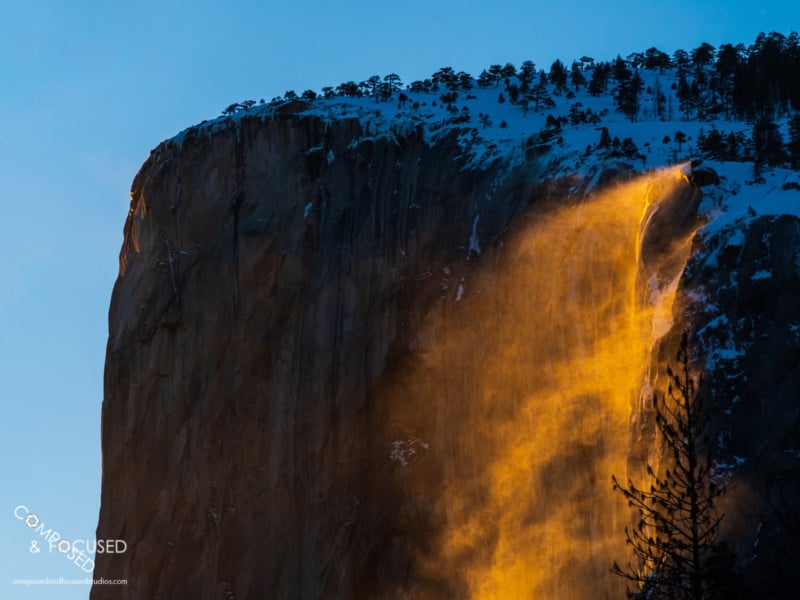
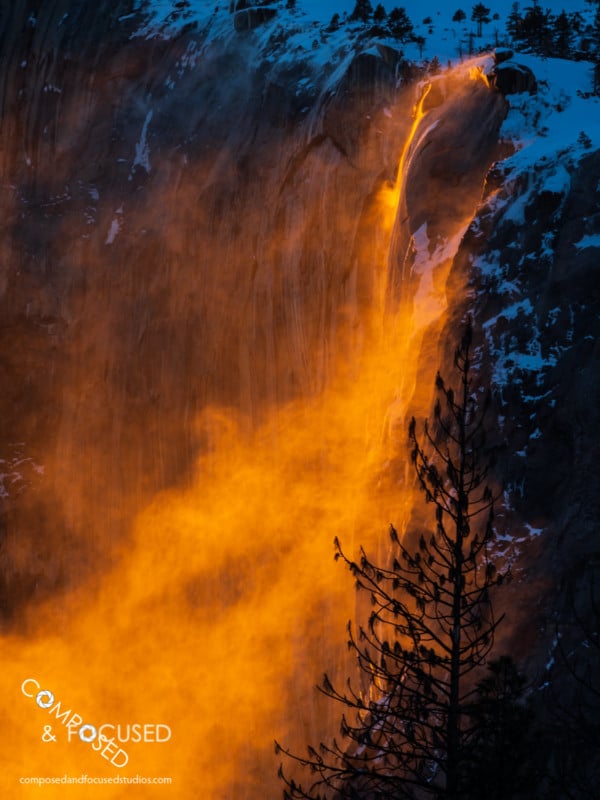
This was the tighter composition I settled with. Lucked out with windy conditions!
Friday the 22nd
Friday the 22nd was estimated to be the peak for Firefall and was supposed to be “the day” for me. I really liked my photo from Thursday, but I wanted to see if it would look better without the tree silhouette I had. I went to get breakfast in the Lodge and quickly realized how many people were coming in for the weekend just to see Firefall.
I overheard the staff telling guests that all accommodations in the Valley were sold out, so I now knew that I’d either have to sleep in my car or leave the park and come back if I wanted to try again on Saturday. People who were chatting with me on Thursday saying that they wanted to head down started messaging back with “there’s too many people going and the weather looks bad for the rest of the weekend”. A quick search of the weather forecast during breakfast made me decide to pack up and head home after Firefall, meaning today was my last chance this year.
I had originally thought to move my car someplace closer, but that wasn’t going to work. Most of the parking spots were closed and the only closer lot was Camp 4…a whopping maybe fifth of a mile closer. By the time I checked out, I figured it was also too late to move to Camp 4 parking because there were massive crowds walking around.
I wolfed down lunch and began my walk over. I took the longer, packed down way along the road and was alarmed when I saw two photographers leaving about a fifth of a mile from the spot. “There’s already a lot of people,” they said.
Before Firefall
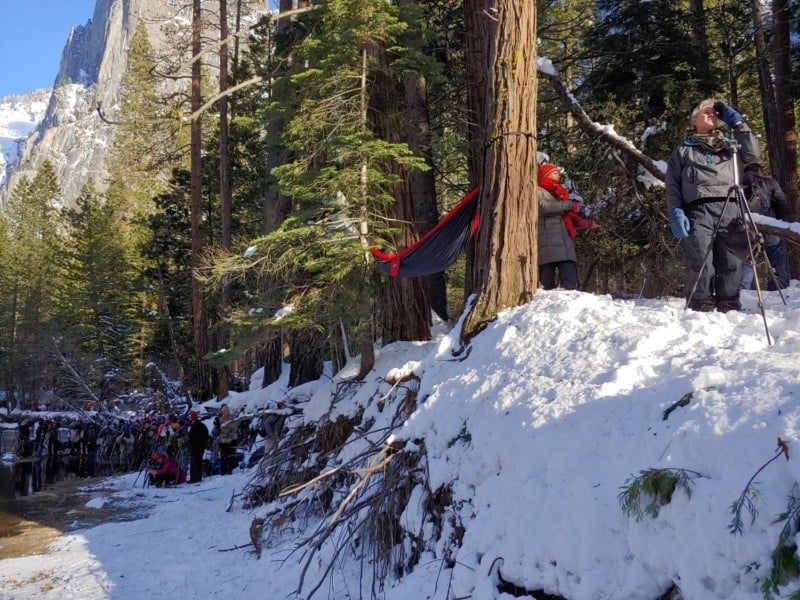
I arrived at 1:10 and there were already 20-30 people in the spot I wanted to use. Some were actually there waiting, some had left tripods and chairs and walked away to do something else. Again, I politely asked to squeeze in amongst the people already set up and was very graciously let in. Some even fed me a little and offered to change their setups so I could fit in. After setting up my gear, there was a lot of second guessing going wide or going tight, gear talk, and just general hanging out with other photographers. We had about 5 hours to go.
I got cabin fever and went for some walks in the snow at 4 pm. I wanted to see the other groupings of photographers and count how many there were. I ended up chatting with two volunteer rangers who were doing site impact surveys and they told me there were 100 people in a smaller area in front of where I was. Likely over 200 people total on the southside. The trips people made to see this were crazy. Some told me they decided to go on a whim and left at 2am to get a spot at 9am. Some said they weren’t planning on sleeping after Firefall and driving back home directly. Plenty mentioned leaving the park and sleeping in their cars.
“The Show”
Composition-wise, I did end up finally deciding to go for the tight crop. There were some clouds in the sky that made for better backgrounds than on Thursday, but my viewing spot had too many branches for me to like the results. I aimed the camera hoping to get the same wind gusts we got on Thursday, but no such luck. Check the photos below to see how the lighting conditions change from the same exact spot.
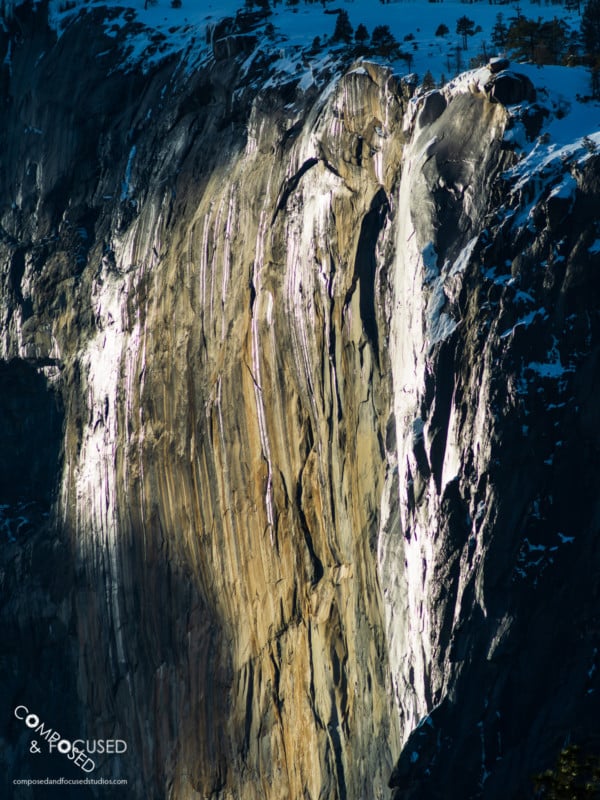
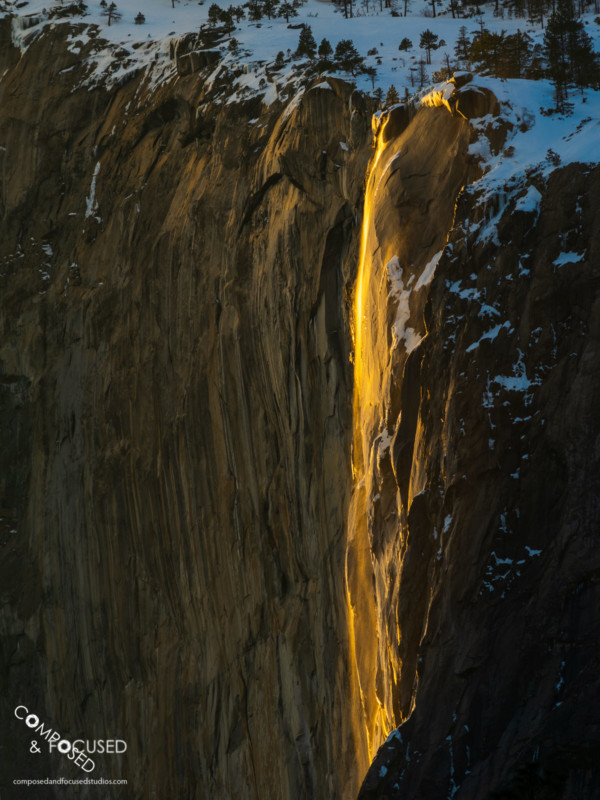
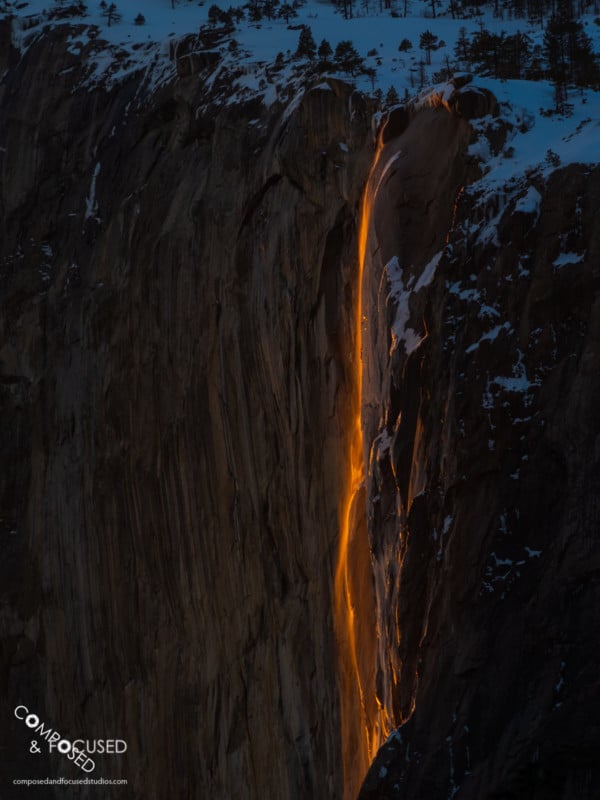
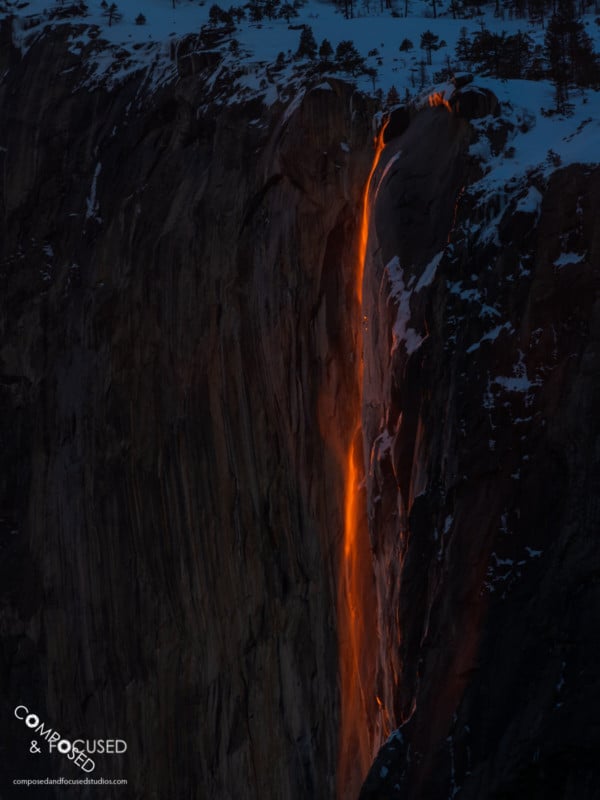
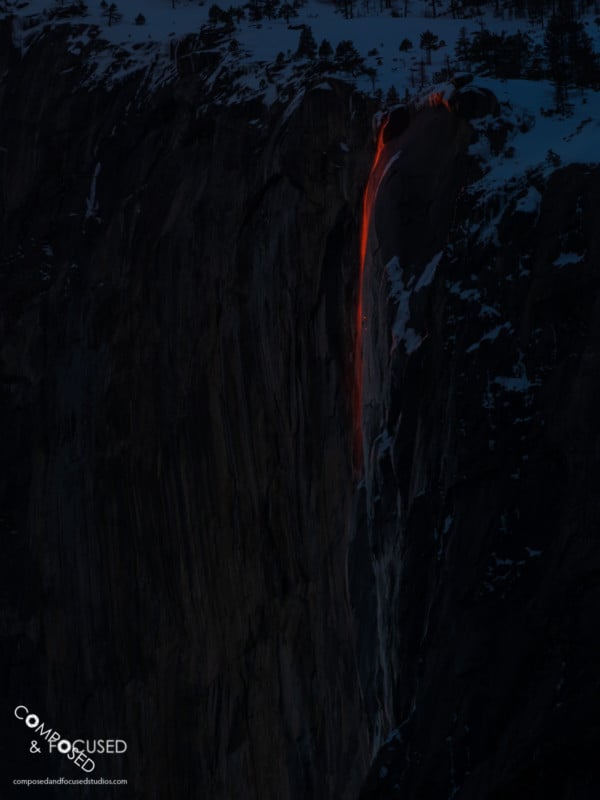
Despite the lack of wind making for a dramatic photo, Friday was also a great experience! Chatting with more people and everyone just being kind all around definitely helped as we all sat or stood in the cold. As far as I know, there was only one jerk on Friday. He showed up at around 3:45 pm, walked directly in front of all the photographers and complained that everyone was in his spot since he “needed to shoot ultrawide”. He was asked to leave and show up earlier next year.
I lingered at the spot after sunset for a little bit to just look at El Capitan. There’s nothing quite like how it looks when clouds are visible, in my opinion. I didn’t get a photo of it because I just wanted to really appreciate the view for myself instead of unpacking everything and setting up again for a completely different shot in the quickly fading light.
After that, I went back home. I should’ve planned better or slept better as I almost fell asleep in the car and promptly fell asleep once I hit the bed at 11.
I’m glad I didn’t stay for Firefall on Saturday, as the weather did not cooperate at all. I’m sure people got some glorious sunset photos, but the clouds prevented Firefall from showing and instead made the rest of the valley very pretty.
James Mead, whom I met Thursday evening, gave me a breakdown as to what happened Saturday. He didn’t actually go for Firefall because of the forecast and instead spent the day getting creative with ice falls before settling in for sunset shots. He hung around until about an hour after sunset and, on the six-mile drive down into the valley, passed 100 + cars going up 120. “Absolutely insane in the valley, with more traffic than even at the high point of summer or the Memorial Day and Labor Day weekends,” he said.
For 2019, there were projections for Firefall conditions lasting about two weeks. However, in chatting with people who visited earlier than I did and keeping tabs on the weather conditions, I found out that the real viewing conditions were much smaller. People told me the Falls first lit up on February 18th, with decent viewing on the 19th. Weather blocked the light from the 15th to 17th, and likewise again from the 23rd to the 27th. I had actually thought of making a day trip to try to reshoot the falls sometime between the 25th and 27th, but it began snowing in the valley. That left only four viewing days out of the whole year!
Honestly, I think the experience being there was worth it. However, one can’t have an attitude going there about getting the best photo of the Firefall. You will be packed in with hundreds of other people who will get almost the exact same photo as you, so if there’s ever a time to be welcoming and get along with others, it is during Firefall.
![]()
I think I prefer the random photos I got while walking around and just paying attention to my surroundings over my Firefall photo just because they are more unique.
I obviously remember getting the picture and seeing the results, but I remember the people around me more as they helped make the experience. The whooping and yelling from excited photographers as the wind blew the mist into clouds sounded like a sports event. The adoring “wows” in multiple languages as people watched the falls change color seemed to amplify my own goosebumps. The chats I had with people were great. Some were about their trips in or favorite destinations, others about what they were looking to do with their visit; some wanted to get a killer shot, some were relatively new to photography and just wanted a reason to use their gear, and some were all about the experience of being there. One of the coolest groups I chatted with didn’t even have any cameras. They made it all the way to Yosemite to see the Firefall since they heard so much about it and wanted to see it for themselves. During “the show”, the dad even started asking what to delete from his phone so he could get more photos and video and commented, “I should probably get a real camera. I’ve been thinking about it for so long.”
I think this experience reminded me to live in the moment with others, but also not to be a jerk to people. When I chatted with Rangers and staff at Yosemite, they all discussed that they’re pretty ambivalent on Firefall. On the one hand, it brings a lot of tourism to the already famous park. On the other hand, very few of these tourists want to do anything other than grab some photos and leave. Plus, the reduced winter staffing seemed to make things more difficult for the employees. Lastly, what made things harder for them this year was getting back up to speed after the government shutdown and the huge amounts of rain and snow causing landslides that closed or damaged portions of the park.
About the author: Aaron Chen is a photographer based in the San Francisco Bay Area. The opinions expressed in this article are solely those of the author. You can find more of Chen’s work on his website, Twitter, and Instagram. This article was also published here.